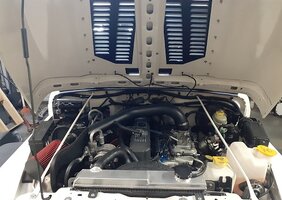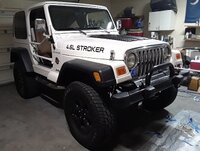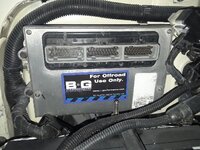My TJ is a Stroker and has 1.50 and 1.96 Chevy valves to accommodate cams with higher lifts. I want to install a Comp cams 68-235-4 with a 210/218 Duration at .050". 111 Degree Lobe Separation Angle. 0.477"/0.493" Valve Lift . It has an operating range of 1000 - 5200 rpm. The catch is that it's not a computer controlled cam. Since the ECM was reprogrammed to eliminate restrictions, Jegs tech support says it will work. What say you guys?
You are using an out of date browser. It may not display this or other websites correctly.
You should upgrade or use an alternative browser.
You should upgrade or use an alternative browser.
Non-computer controlled cam with reprogrammed computer
- Thread starter HarleyMick
- Start date
My TJ is a Stroker and has 1.50 and 1.96 Chevy valves to accommodate cams with higher lifts. I want to install a Comp cams 68-235-4 with a 210/218 Duration at .050". 111 Degree Lobe Separation Angle. 0.477"/0.493" Valve Lift . It has an operating range of 1000 - 5200 rpm. The catch is that it's not a computer controlled cam. Since the ECM was reprogrammed to eliminate restrictions, Jegs tech support says it will work. What say you guys?
I would want to know the specs of your current cam before I tried to compare the two. Can you not alter the ECM tables to accommodate any given grind?
The current cam is a comp 68-232-4 with a 206/212 duration at .050" 113 lobe separation and 0.460 /0.476 valve lift. It has an operating range of 800-4,800 rpm. Not a drastic change in numbers.
Maybe I should add that it has Bosch 24 lb fuel injectors, a 62 mm throttle body, low restrictive air intake and no restrictive exhaust from the header on.
Maybe I should add that it has Bosch 24 lb fuel injectors, a 62 mm throttle body, low restrictive air intake and no restrictive exhaust from the header on.
Last edited:
The current cam is a comp 68-232-4 with a 206/212 duration at .050" 113 lobe separation and 0.460 /0.476 valve lift. It has an operating range of 800-4,800 rpm. Not a drastic change in numbers.
Maybe I should add that it has Bosch 24 lb fuel injectors, a 62 mm throttle body, low restrictive air intake and no restrictive exhaust from the header on.
So, it looks like you're just shifting the powerband down a bit; I would think that if your programming is already happy with the first cam, it'll be fine with the second because there's just not much difference in them...and you've already had someone make adjustments for everything else, yes?
So, it looks like you're just shifting the powerband down a bit; I would think that if your programming is already happy with the first cam, it'll be fine with the second because there's just not much difference in them...and you've already had someone make adjustments for everything else, yes?
Yes, nearly all limitations have been removed.
Yes, nearly all limitations have been removed.
Well, if this is a situation where you're telling the computer what's happening in terms of air and fuel, then you're effectively removing its relevance from the equation: it's just going to do what you tell it to do. A better question is to ask how well the new cam is going to play with the head...but if you've got enough airflow to support a mild cam in the 4.6 stroker, then you probably have enough airflow to support a similar cam at 200 less revs. I could care less about the intake and exhaust until the actual flow through the head is taken care of; do you have any bench numbers for whatever's been done to your head?
Excuse my ignorance, but I have no numbers except the size of the new valves and throttle body. I personally made flush and polished the point of attachment for the 62 mm throttle body as well as the intake ports of the intake manifold. You're probably laughing at me for my lack of technical knowledge and that is totally OK. That's why I'm turning to you guys before I install the new cam.
Dave Casper reprogrammed the ECM and I paid $300 for larger valves and stronger springs before I installed the first Comp Cam 68-232-4. I was told they were made for a Chevy small block. Do you think I should send the 68-235-4 back or do you have a suggestion on increasing air intake? I appreciate any help or advice.
Dave Casper reprogrammed the ECM and I paid $300 for larger valves and stronger springs before I installed the first Comp Cam 68-232-4. I was told they were made for a Chevy small block. Do you think I should send the 68-235-4 back or do you have a suggestion on increasing air intake? I appreciate any help or advice.
Don't believe you will have any problems running the Comp Cam 68-235-4. I've been running the Comp Cam 68-235-4 with upgraded valve springs in my Jeep for over a year now and really like the performance. I didn't have to get my ECM reprogram to run it. Probably could gain some more performance if I would. Sure that will be a future upgrade.
Dave Casper reprogrammed the ECM and I paid $300 for larger valves and stronger springs before I installed the first Comp Cam 68-232-4. I was told they were made for a Chevy small block. Do you think I should send the 68-235-4 back or do you have a suggestion on increasing air intake? I appreciate any help or advice.
Well, as evidenced by this...
Don't believe you will have any problems running the Comp Cam 68-235-4. I've been running the Comp Cam 68-235-4 with upgraded valve springs in my Jeep for over a year now and really like the performance. I didn't have to get my ECM reprogram to run it. Probably could gain some more performance if I would. Sure that will be a future upgrade.
...it doesn't look like you'll have any problems. I'm not sure how much can be learned about the cam performance, though, without actually knowing what the head can flow. Sure, you might snap the valves open faster or further or longer or at a different time, but unless those actions allow more airflow through the head, they're pointless. Same goes for your intake: until you know what the head can do, sizing all the rest of it is a shot in the dark.
How do I find out the flow rate of the head? Ask the manufacturer?
Yes.
Here's an update, Chad Golen built me a head from and older model with a higher flow rate, ported with oversized Chrysler valves and I added Harland aluminum roller rockers. The cam is made by Comp Cams with a 5.06 lift and the pushrods are heavier. I added 26 lb. Bosch fuel injectors and a 68 mm throttle body along with functional hood louvers to feed it cooler air. As far as any further specs, I just cannot retain them. I also added 18" wheels with 305/70 18 tires.




Okay, so there is a lot to unpackage here. To start, you keep mentioning the PCM had the "restrictions removed." I'm not really sure what you mean by that. Ideally the PCM would be retuned to make sense of the new perameters of the engine specifically the bigger injectors, cam characteristic, different volumetric efficiency, etc. There are no "restrictions" to be removed except maybe the speed limiter? Maybe turning off the O2's (which isn't legal but I'm not judging). You need to know what your PCM was tuned for to have any idea how it will behave.
I think your original question was will that cam throw a CEL. I think the answer is it depends. My stroker has just shy of 10:1 compression and a bigger cam than you bought. It also has a lot of other things but those are what matter for daily driving the most. On a stock tune I will throw an O2 high voltage code (basically it's running rich) shortly after the motor reaches operating temp and completes it's O2 diagnostic cycle. Maybe your setup would throw a code, maybe it wouldn't. If it does, the PCM needs to be tuned to make it understand what's going on. That or swap cams again.
Big cams with lots of duration and overlap reduce the amount of vacuum at idle and confuses the PCM. The bigger the cam, the more this happens. It eventually gets to a point where the PCM goes outside it's factory programmed perameters and it throws a code. None of the above is aimed at WOT tuning.
My cam card is attached below for reference.

I think your original question was will that cam throw a CEL. I think the answer is it depends. My stroker has just shy of 10:1 compression and a bigger cam than you bought. It also has a lot of other things but those are what matter for daily driving the most. On a stock tune I will throw an O2 high voltage code (basically it's running rich) shortly after the motor reaches operating temp and completes it's O2 diagnostic cycle. Maybe your setup would throw a code, maybe it wouldn't. If it does, the PCM needs to be tuned to make it understand what's going on. That or swap cams again.
Big cams with lots of duration and overlap reduce the amount of vacuum at idle and confuses the PCM. The bigger the cam, the more this happens. It eventually gets to a point where the PCM goes outside it's factory programmed perameters and it throws a code. None of the above is aimed at WOT tuning.
My cam card is attached below for reference.
If he custom tuned your PCM to your current setup and it runs well, I doubt a small change in cam specs will make it throw a code, but I'm no wizard for cam specs and I think it would be tough to say for sure not only about it throwing a code but also about it running well. Would a retune be out of the question? Why are are swapping cams?
If he custom tuned your PCM to your current setup and it runs well, I doubt a small change in cam specs will make it throw a code, but I'm no wizard for cam specs and I think it would be tough to say for sure not only about it throwing a code but also about it running well. Would a retune be out of the question? Why are are swapping cams?
The engine was first rebuilt for performance by Titan and is actually a 4.7L. I don't want to go into all of the shortcuts subpar machining that caused the engine to be a big disappointment that only lasted about a month. Rather than pay to have the engine shipped back to Titan and have them decide if the problems were their fault I sent it to Golen Engine Services. The cam from Titan had a lobe worn down, a lifter scooped out and a broken pushrod. I had Chad go top of the line on everything including balancing and blueprint. He said it could handle the 68-235-4 Comp Cam which would give me a power range of 1000 - 5200 rpm.
I get no codes and it runs very strong producing 325 lbs. of torque. It also has a 3 year warranty with unlimited mileage. I had the rev limit set at 5,500 rpm but never take it over 5,000. I'm turning it into a show Jeep that will also go.


